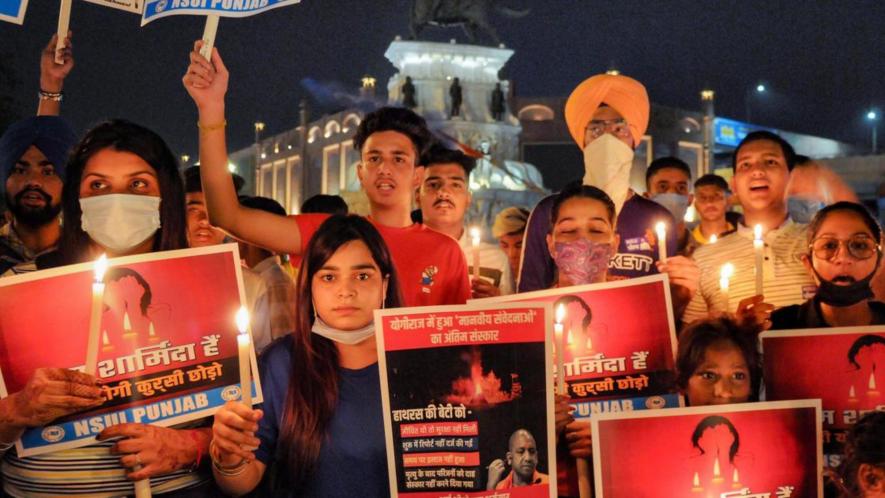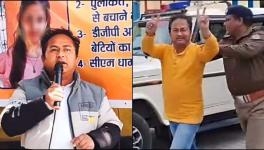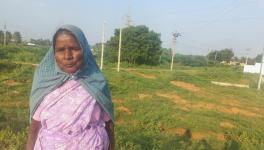Hathras Verdict: Justice Not Delivered

Candle march for the 20-year-old woman from Hathras. Image Courtesy: PTI
The Hathras case of 2020 represents a distressing chapter in India’s ongoing struggle with gender-based violence and caste discrimination. This deeply troubling incident, characterised by rape, murder, and alleged systemic failures, has garnered global attention and prompted widespread outrage and demands for justice. To fully comprehend the Hathras case, and the verdict of the Sessions Court on March 2, 2023, that only partially held one accused guilty, it is crucial to delve into its factual, historical, and legal context.
Verdict of the Court-
-
Conviction of Sandeep Sisodia (Chandu): The court found Sandeep Sisodia guilty under Section 304 Part 1 of the IPC, which deals with culpable homicide not amounting to murder. This verdict suggests that the court believed that Sandeep was involved in the incident, but it did not consider it a premeditated murder. Instead, the court appears to have concluded that the victim’s death was the result of Sandeep dragging her by her dupatta, which led to her becoming unconscious and ultimately dying during treatment.
- Reasons for Conviction: The court cited evidence such as medical examination reports, post-mortem reports, and the victim’s mother’s testimony as credible. The presence of ligature marks and the statements made by the victim and her mother were likely key factors in the court’s decision to convict Sandeep. The court may have believed that while Sandeep’s actions resulted in the victim’s death, there might not have been a clear intent to murder her.
- Acquittal of Ravi, Ramu, and Lavkush: The court acquitted the other three accused, Ravi, Ramu, and Lavkush, of all charges, including gang rape and murder.
- Reasons for Acquittal: The court appears to have found insufficient evidence to link Ravi, Ramu, and Lavkush directly to the crime. It noted inconsistencies in the victim’s statements and suggested the possibility of her being tutored due to the political nature of the case. Additionally, the court cited the principle that “FALSUS IN UNO FALSUS IN OMNIBUS” (false in one thing, false in everything) is not applicable in India, meaning that inconsistencies in the victim’s statements did not necessarily render her entire testimony unreliable.
Ratio:
The court’s central observations and findings can be summarised as follows:
- Factual Inquiries:
- The court conducted a detailed examination of the factual context, highlighting the victim’s identity as a Dalit woman and the circumstances surrounding the brutal assault on September 14, 2020.
- The court noted that the victim’s family initially faced difficulties in registering an FIR, and there were allegations of insensitivity by the police, which led to criticism of their handling of the case.
- Charges and Evidence:
- The accused faced charges under various sections of the IPC, including rape, murder, and gang rape, as well as under the SC/ST (Prevention of Atrocities) Act.
- The victim’s statement, made as a dying declaration before a magistrate, served as a crucial piece of evidence in the case. In this statement, she named her attackers and provided details of the assault.
- Medical reports and post-mortem findings corroborated the nature of injuries sustained by the victim, including ligature marks on her neck.
- Acquittal of Three Accused:
- The court acquitted three of the four accused of all charges, including gang rape and murder. The accused Ravi, Ramu, and Lavkush were found not guilty.
- The court’s decision was based on an analysis of the evidence and the victim’s statements, which did not conclusively establish the involvement of these three accused in the crimes.
- Conviction of Sandeep Sisodia:
- The court found the fourth accused, Sandeep Sisodia alias Chandu, guilty of culpable homicide not amounting to murder under Section 304 Part 1 IPC and under Section 3(2)(v) of the SC/ST (Prevention of Atrocities) Act.
- The court ruled that Sandeep had dragged the victim by her dupatta, resulting in her unconsciousness and eventual death due to complications arising from a cervical fracture. However, the court did not find evidence to establish the intent to murder the victim.
- The verdict led to Sandeep’s conviction and potential sentencing to life imprisonment or up to ten years in prison.
Obiter:
While the central findings of the court related to the acquittal of three accused and the conviction of Sandeep Sisodia, certain obiter dicta were also significant:
- Principle of “Falsus in Uno, Falsus in Omnibus”:
- The court noted that the principle of “Falsus in Uno, Falsus in Omnibus” (false in one thing, false in everything) is not applicable in India. It recognized that witnesses may have elements of falsehood or exaggeration in their testimonies.
- The court emphasized the duty of the court to carefully analyse and separate credible evidence from unreliable portions.
- Medical Evidence and Ligature Marks:
- Medical evidence played a critical role in the court’s judgment. Doctors who treated the victim and conducted the post-mortem examinations provided corroborative evidence of the injuries sustained.
- The court noted that while ligature marks were found on the victim’s neck, there were no marks on the rear side of her neck. Medical experts opined that the injury might have been caused by a single impact or forceful jerk, rather than strangulation through a dupatta.
- Intent to Murder:
- The court found that the evidence did not establish the intent to murder the victim. It noted that the victim had continued to converse about the incident for eight days after the assault, suggesting a lack of intention to kill.
- Legal Provisions and Sentencing:
- The court highlighted the legal provisions under which the accused were charged and convicted. It noted that Sandeep Sisodia was liable for punishment under Section 304 Part 1 IPC and Section 3 (2) (v) of the SC/ST (Prevention of Atrocities) Act, which could lead to life imprisonment or up to ten years’ imprisonment.
Key Takeaways:
The court’s observations in the Hathras case carry significant implications and key takeaways:
- Caste Discrimination and Vulnerability: The case underscores the vulnerability of Dalit women to sexual violence and caste-based discrimination, highlighting the urgent need for comprehensive reforms to address these deeply rooted issues.
- Gender-Based Violence: The verdict serves as a stark reminder of the persistent problem of gender-based violence in India. It emphasizes the need for sustained efforts to address root causes and ensure justice for survivors.
- Legal System Scrutiny: The case prompted intense scrutiny of India’s legal system, with questions about evidence, witness treatment, and trial conduct. This raises concerns about the delivery of justice in similar cases and the need for procedural reforms.
- Advocacy and Public Outrage: The Hathras case ignited widespread public outrage and advocacy efforts, demonstrating the power of civil society organizations, activists, and citizens in demanding accountability and systemic changes.
- Complexity of Legal Cases: The case exemplifies the complexity of legal cases involving sexual violence, where evidence, medical reports, and witness testimonies play pivotal roles in determining the outcome.
In conclusion, the Hathras case serves as a poignant reminder of the multifaceted challenges India faces in its pursuit of gender equality, social justice, and the eradication of caste-based discrimination.
Importance from a Human Rights Perspective:
The Hathras case is not merely a criminal trial; it represents a significant human rights issue with implications that stretch beyond the courtroom. It exposes glaring doubts about due process and the treatment of marginalized communities in the Indian criminal justice system. The victim’s family and activists argue that the initial investigation by the Uttar Pradesh police was marred by bias and negligence, pointing to systemic issues that continue to hinder the protection of human rights.
One of the most distressing aspects of the Hathras case is the manifestation of deeply ingrained caste-based discrimination in India. The victim, a Dalit, faced not only the trauma of sexual assault but also the potential denial of justice due to her social status. This verdict further questions the state’s commitment to protecting the rights of marginalized communities, especially those from lower castes.
Positive Implications on Human Rights Jurisprudence:
Despite the ghastly nature of the Hathras mass crime, are there any aspects that can be viewed positively from a human rights perspective?
Firstly, the judgment underscores the importance of dying declarations in rape trials. While the court’s decision has been seriously disputed, the fact that it reaffirms the significance of the victim’s statements as powerful evidence in such cases, is a small positive. Dying declarations serve as a testament to the victim’s last wishes, providing crucial insights into the circumstances of their assault.
Secondly, there is little consolation in the fact that the verdict reignites discussions about the role of law enforcement agencies and the need for accountability in handling sensitive cases. The hasty cremation of the victim without her family’s consent shocked the nation, and it reflects broader issues surrounding police conduct and the potential consequences of such actions. The case acts as a reminder that accountability is a cornerstone of human rights protection. The officials responsible for carrying out the illegal and hasty cremation in the dark of the night, and the failure of the investigation and prosecution in tracking who’s orders resulted in this criminality is another huge flaw in the verdict.
However, the fact that the individuals in law enforcement responsible for the 11-day delay in recording the forensic evidence have gone unpunished is a huge flaw in the judicial pronouncement.
Negative Implications on Human Rights Jurisprudence:
However, the significant negative implications stemming from the Hathras verdict outweigh any others, particularly those concerning the handling of evidence and the potential normalisation of victim-blaming.
The court’s reliance on a forensic report, conducted after an 11-day gap, raises concerns about the timing and integrity of evidence collection and as mentioned the above, the reluctance of the court to hold any official or medico-legal professional guilty for this dereliction of duty. This may yet set one more dangerous precedent, potentially allowing perpetrators to evade justice due to procedural delays. In essence, it shifts the burden of proof away from the accused and onto the victim, undermining the principles of justice and human rights.
The scepticism exhibited in the judgment about the victim’s changing statements could well normalise victim-blaming and deter survivors from coming forward to report sexual assault, fearing they may not be believed. This is especially troubling in a country where stigmatisation of survivors and underreporting of sexual violence are already major concerns.
Future Litigation, Advocacy, and Activism:
The Hathras case is far from settled, as the victim’s family has decided to appeal the verdict, marking the beginning of an ongoing battle for justice. Future litigation will focus on highlighting the inadequacies of the judgment, seeking redress for the victim’s family, and setting important legal precedents.
Beyond the legal realm, the Hathras case has sparked widespread human rights activism. Civil society organizations, activists, and concerned citizens have united to demand justice for the victim. This verdict serves as a rallying point for ongoing advocacy efforts to address caste-based discrimination, gender-based violence, and systemic issues within the Indian legal system.
Subsequent Use in Legal Proceedings and Advocacy:
The Hathras verdict is likely to be cited in future legal proceedings and human rights advocacy in India for several reasons:
Firstly, the handling of the victim’s statements, particularly her dying declaration, will likely be cited in cases where such declarations are central to the prosecution’s argument. This highlights the importance of transparent and thorough investigation procedures that ensure the preservation of crucial evidence.
Secondly, advocates and activists may invoke this case to shed light on the challenges faced by Dalits and other marginalized communities in accessing justice and confronting caste-based discrimination. The Hathras case is not an isolated incident but rather emblematic of systemic issues that persist in India.
Lastly, the case serves as a reminder of the need for accountability and impartiality within law enforcement agencies and the casualness and failure to commandeer such accountability by India’s courts. Future efforts to reform police procedures and practices may draw on the Hathras case as a stark example of what can go wrong when authorities fail to uphold human rights.
Conclusion
In conclusion, the Hathras case verdict, from a critical perspective, raises deep concerns and questions about the state of justice, particularly for marginalised communities in India. While it is important to acknowledge the complexities of legal proceedings, this judgment has been met with significant scepticism and disappointment. The acquittal of three of the accused, despite compelling evidence and the victim’s dying declaration, highlights the deficiencies within the criminal justice system.
From a human rights perspective, the verdict signals a potential setback in the pursuit of justice for survivors of sexual violence and marginalized communities, particularly Dalits. The scepticism regarding the victim’s statements and the reliance on procedural technicalities may deter survivors from coming forward, further perpetuating a culture of silence and impunity.
Moreover, the Hathras case verdict underscores the need for urgent reforms in the police and legal systems to ensure unbiased investigations, timely evidence collection, and transparent proceedings. It also underscores the broader issues of gender-based violence and caste discrimination that continue to plague Indian society.
While this judgment is a significant setback, it has also ignited a renewed sense of determination among human rights activists, civil society organizations, and concerned citizens. It serves as a poignant reminder that the fight for justice, equality, and the eradication of caste-based discrimination is far from over.
Background
Factual Context:
In September 2020, a 19-year-old Dalit woman, belonging to one of India’s most marginalized communities, became the victim of an appalling crime. Her identity as a Dalit is significant because it exposes the entrenched issues of caste discrimination and vulnerability faced by this community. Dalits, also known as Scheduled Castes, have historically endured social exclusion, economic disadvantage, and violence in India’s rigid caste system.
The incident unfolded in Hathras district, Uttar Pradesh, a state notorious for high rates of gender-based violence. On September 14, 2020, the victim and her mother were working in the fields when the young woman was brutally attacked. She was found in a severely injured state, her tongue cut off, and her body bearing signs of extreme violence. Her mother, who was working nearby, rushed to her side upon hearing her cries. This incident shattered the victim’s life and irrevocably altered the course of her family’s existence.
Following the attack, the victim was rushed to the local police station to report the crime. However, the police’s response at this initial stage of the incident became a subject of scrutiny and criticism. Allegedly, they delayed registering an FIR (First Information Report) and displayed insensitivity towards the victim and her family. Reports suggest that the police even suggested that the family take the victim away, further compounding their trauma.
The victim’s family persisted in their quest for justice, and an FIR was eventually filed against one of the accused, Sandeep, under Section 354 of the Indian Penal Code (IPC). This section pertains to assault or criminal force to a woman with the intent to outrage her modesty. The victim’s statement at this juncture, detailing her ordeal, marked the beginning of a harrowing legal journey. The accused included-
- Sandeep Sisodia (Chandu): Sandeep was the primary accused in the case and was initially charged with several offenses, including rape, attempt to murder, and other sections of the Indian Penal Code (IPC) and the Scheduled Castes and Scheduled Tribes (Prevention of Atrocities) Act. His name was prominently featured in the victim’s initial statement, and he was arrested soon after the incident.
- Ravi: Ravi was one of the three other accused in the case. He, along with the others, faced charges of gang rape, murder, and other related offenses. The victim’s statements and the evidence presented in the case implicated Ravi in the assault.
- Ramu: Similar to Ravi, Ramu was accused of participating in the gang rape and murder of the victim. The charges against him were severe, and he was a key figure in the case.
- Lavkush: Lavkush was the fourth accused in the case. He, too, faced charges related to the gang rape and murder of the victim. All four accused were from the same village as the victim and belonged to a different caste group.
It’s important to note that the legal proceedings against these accused individuals involved a complex investigation, the examination of evidence, and testimonies from witnesses. The recent court verdict in the case resulted in the acquittal of Ravi, Ramu, and Lavkush, while Sandeep Sisodia (Chandu) was found guilty of culpable homicide not amounting to murder.
The case’s legal outcomes have sparked significant debate and controversy, with concerns raised about the handling of the trial and the need for justice in cases of sexual violence and caste-based discrimination. Public and legal discussions surrounding this case continue to focus on the broader issues of gender-based violence, caste discrimination, and access to justice for marginalized communities in India.
Historical Context:
To fully comprehend the Hathras case, one must appreciate its historical backdrop, marked by caste-based discrimination and gender-based violence.
Caste-Based Discrimination in India:
Caste-based discrimination in India has a long and deeply entrenched history, dating back thousands of years. It is a system of social hierarchy and stratification where individuals are categorized into specific groups known as “castes.” At the top of this hierarchy are the “Brahmins” (priestly class), followed by various other castes, with the “Dalits” (Scheduled Castes) at the bottom. Dalits have historically been subjected to systemic discrimination, social exclusion, and economic marginalization.
The Hathras case highlighted the victim’s identity as a Dalit, emphasizing the structural inequalities and vulnerabilities faced by this community. Dalit women, in particular, are at the intersection of caste and gender-based discrimination, often experiencing multiple forms of oppression. They are more susceptible to violence, exploitation, and abuse, making them one of the most marginalized groups in Indian society.
Gender-Based Violence in India:
Gender-based violence is a pervasive and persistent issue in India. It encompasses various forms of violence directed against individuals based on their gender, with women and girls disproportionately affected. This includes sexual harassment, domestic violence, rape, acid attacks, and other forms of abuse.
The Hathras case is one of many instances that have evoked memories of previous cases of sexual violence against women in India, such as the infamous 2012 Delhi gangrape case. The Delhi case, which involved a brutal gang rape and murder of a young woman on a bus, sparked outrage and led to nationwide protests demanding justice and changes in the legal framework.
Reforms and Challenges:
In the wake of the 2012 Delhi gangrape case, India did introduce significant reforms to its laws related to sexual violence. The Criminal Law (Amendment) Act, 2013, commonly known as the Nirbhaya Act, was enacted to provide stricter penalties for perpetrators of sexual offenses, including the death penalty in certain cases.
However, despite legislative changes and increased public awareness, gender-based violence continues to be a pressing issue in India. Several factors contribute to this ongoing problem, including:
- Patriarchal Norms: Deep-rooted patriarchal norms and attitudes persist in many parts of Indian society, perpetuating the subjugation of women and girls.
- Underreporting: Many cases of gender-based violence go unreported due to social stigma, fear of retaliation, and distrust of the criminal justice system.
- Slow Legal Processes: Delays in the legal system can discourage survivors from seeking justice, and cases can linger in courts for years.
- Structural Inequalities: Intersectional factors, such as caste and class, intersect with gender, intensifying vulnerabilities for marginalized women.
- Police and Legal System Challenges: Issues related to police responsiveness, evidence collection, and the conduct of trials can hinder the pursuit of justice.
In conclusion, the Hathras case serves as a stark reminder that addressing gender-based violence and caste-based discrimination in India requires not only legal reforms but also significant societal changes. These issues are deeply interconnected and demand a comprehensive and sustained effort to combat them effectively and ensure a more equitable and just society for all.
Legal Context:
The legal context of the Hathras case is multifaceted and pivotal to understanding its progression.
- Indian Penal Code (IPC): The IPC is India’s primary criminal code, encompassing provisions related to a wide range of offenses, including rape, assault, and murder. The accused in the Hathras case faced charges under various sections of the IPC, including Section 307 (attempt to murder) and Section 354 (assault or criminal force to a woman with intent to outrage her modesty).
- Scheduled Castes and Scheduled Tribes (Prevention of Atrocities) Act: In addition to the IPC charges, the accused were also charged under the Scheduled Castes and Scheduled Tribes (Prevention of Atrocities) Act. This legislation is designed to protect Dalits and tribal communities from violence, discrimination, and exploitation.
- Dying Declaration: A critical element of the legal proceedings in the Hathras case was the victim’s dying declaration. In this statement, made before a magistrate, she named her attackers and provided details of the horrific assault. The dying declaration served as a crucial piece of evidence in the trial.
- Criminal Investigation: The case underwent initial investigation by local police authorities but was subsequently transferred to the Central Bureau of Investigation (CBI). The CBI is India’s premier federal investigative agency, responsible for handling complex and high-profile cases.
- Court Proceedings: The trial of the accused in the Hathras case marked a critical juncture in the legal process. In a recent and highly contentious court verdict, three of the four accused were acquitted of all charges, including gang rape and murder. The fourth accused, Sandeep Sisodia, was found guilty of culpable homicide not amounting to murder. This verdict has triggered a flurry of debates, legal challenges, and public outrage.
Role of the UP government and administration-
The administration and government’s handling of the Hathras case after the tragedy came under intense scrutiny and raised significant concerns about attempts to suppress information, undermine the victim’s family, and challenge court orders related to providing help and reparation to the family. Here’s an overview of some key events and actions taken by the Uttar Pradesh (U.P.) government:
- Hasty Cremation: One of the most controversial actions taken by the U.P. government was the hasty cremation of the victim’s body against the wishes of her family. The family had requested that they be allowed to perform the last rites, but the administration conducted the cremation in the middle of the night without their consent. This move was widely criticized and seen as an attempt to quickly dispose of evidence and prevent protests.
- Secrecy and Media Restrictions: The government-imposed restrictions on media access to Hathras and the victim’s family, limiting the flow of information about the case. Journalists were reportedly barred from entering the village, and their movement was restricted. This raised concerns about transparency and accountability in the investigation.
- Blocking Opposition Leaders: Several political leaders from opposition parties, including Rahul Gandhi and Priyanka Gandhi Vadra, were prevented from visiting the victim’s family. This raised questions about the government’s willingness to allow scrutiny and support for the family.
- Challenging Court Orders: The U.P. government was involved in legal battles challenging court orders related to the case. When the Allahabad High Court initially ordered a special investigation by the Central Bureau of Investigation (CBI) into the case, the government challenged this decision but later withdrew its appeal.
- Denial of Compensation: The government faced criticism for initially denying compensation to the victim’s family. Compensation is typically provided to families of victims of crimes, especially in cases of sexual violence. However, the government’s reluctance to provide compensation added to the family’s distress.
- Allegations of Intimidation: There were allegations of intimidation and harassment of the victim’s family. They claimed that they were under pressure to change their statements and were not allowed to speak freely. This raised concerns about their safety and ability to seek justice.
- Political Statements: Some political leaders and officials made statements that appeared to downplay the severity of the crime or question its veracity. These statements were widely criticized for being insensitive and perpetuating a culture of victim-blaming.
- Lack of Empathy: The government’s response to the case was criticized for a lack of empathy and understanding of the trauma experienced by the victim’s family. This included insensitivity displayed by police officers at the initial stages of the case.
In summary, the administration and the U.P. government faced widespread criticism for their actions and responses in the aftermath of the Hathras case tragedy. Many saw these actions as attempts to bury the case, suppress information, and undermine the victim’s family’s pursuit of justice. The challenges posed by the government to court orders and its handling of the case further fuelled concerns about the state of the criminal justice system and the protection of human rights in India.
Get the latest reports & analysis with people's perspective on Protests, movements & deep analytical videos, discussions of the current affairs in your Telegram app. Subscribe to NewsClick's Telegram channel & get Real-Time updates on stories, as they get published on our website.
























